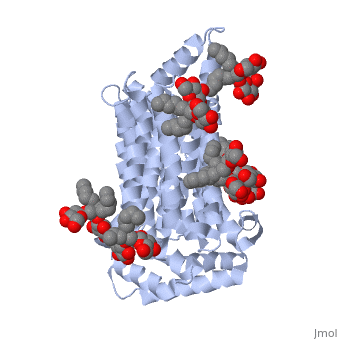Sanbox glut3
From Proteopedia
| Line 5: | Line 5: | ||
== Function == | == Function == | ||
| - | + | <scene name='71/716527/5c65/1'>GLUT3</scene> is one of fourteen facilitative sugar transporters which use the glucose diffusion gradient to move across various plasma membranes to display various specificities, kinetics and tissue expression profiles<ref>Long, W., & Cheeseman, C. I. (2015). Structure of, and functional insight into the GLUT family of membrane transporters. Cell Health and Cytoskeleton, 7, 167-183. doi:10.2147/CHC.S60484</ref> (Long et al. 2015). Glucose transporters are about 500 amino acids in length and are a part of a growing superfamily of integral membrane glycoproteins that have 12 transmembrane (TM) helices. The transmembrane regions presumably create channels through which glucose can move (Kipmen-Korgun et al. 2009). GLUT3 is categorized as a Class I transporter due to its protein sequence and structural similarity to other glucose transporters grouped in Class I (Long et al. 2015). GLUT3 displays the highest affinity for glucose of all of the Class I glucose transporters and has a transport capacity five times greater than that of GLUT1 and GLUT4 (Simpson et al., 2008). In humans, GLUT3 is found predominantly in brain tissue, highly and specifically expressed by neurons, and has some expression in peripheral tissues (Maher et al., 1994; Simpson et al. 2008). It is commonly known as the “neuronal glucose transporter” because of it is most commonly found in the brain, specifically seen mostly in the axons and dendrites of neurons (Simpson et al. 2008). GLUT3 has a more restricted expression pathway, which represents specialized functions for the protein (Xu et al., 2015). GLUT3 has been found to play an important role in gestational development and maintaining the brain's structure. Defects in GLUT3 can cause fetal death as well as neurodegeneration, which can lead to diseases like Alzheimer’s (Liu et al. and Zu et al. 2008). | |
==Structure== | ==Structure== | ||
Revision as of 19:13, 16 November 2015
Facilitated Glucose Transporter 3, Solute Carrier Family 2 (GLUT3/ SLC2A3) in Homo Sapiens
| |||||||||||
Possible Mechanism
Multiple mechanistic theories have been proposed for facilitated glucose transporters. The simple carrier model was the earliest theory proposed by Widdas and contains four steps. First, the empty carrier opens to the cis side of the membrane for glucose to bind1. Then the substrate binding carrier translocates to the trans side of the membrane where it then releases glucose on that side. Last the empty carrier switches to the cis side. Multiple mechanistic theories, including the simple carrier model were proposed but all attempted to explain two key components of GLUT transporters, the asymmetry of the transport affinities and the trans-acceleration that occurs in the presence of hexose on the trans side2. After considerable research, two popular models remain for class 1 glut transporters. The two-site/fixed site transporter theory explains the asymmetry by having both substrate binding sites simultaneously available3. After glucose is bound, hexoses exchange between sites and speed the binding process. Although this method explains the asymmetry and the kinetics of class 1 glut transporters, not all class 1 glut transporters contain asymmetric glucose transporters3. The alternating access model follows three steps4. The transporter has a cavity for small substrates, and contains a substrate binding site. The transporter also has two different configurational openings to one cell membrane or the other. This mechanisms differs from the two-site/fixed site transporter theory by assuming there is only one binding site available at a time, leading to four different conformation states. An empty outward open state, an occluded transporter state, a inward open state and finally another occluded state5. Trans-acceleration is only observed in a minority of class 1 glut transporters6. GLUT3 has been proven to be dependent on trans-acceleration. This method was discovered when hexose was found to be moving against its concentration gradient1. This movement is argued to support both the two-site transporter theory and the alternating access model. Geminate exchange, named by Naftalin et al, explains this movement with the idea that hexose could exchange freely between two binding sites within the carrier. While other scientist argue that hexose could move from outward to inward without glucose binding7.
References
- ↑ Hanson, R. M., Prilusky, J., Renjian, Z., Nakane, T. and Sussman, J. L. (2013), JSmol and the Next-Generation Web-Based Representation of 3D Molecular Structure as Applied to Proteopedia. Isr. J. Chem., 53:207-216. doi:http://dx.doi.org/10.1002/ijch.201300024
- ↑ Herraez A. Biomolecules in the computer: Jmol to the rescue. Biochem Mol Biol Educ. 2006 Jul;34(4):255-61. doi: 10.1002/bmb.2006.494034042644. PMID:21638687 doi:10.1002/bmb.2006.494034042644
- ↑ Long, W., & Cheeseman, C. I. (2015). Structure of, and functional insight into the GLUT family of membrane transporters. Cell Health and Cytoskeleton, 7, 167-183. doi:10.2147/CHC.S60484

